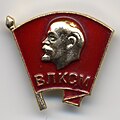Komsomol
This article needs additional citations for verification. (January 2007) |
| Komsomol | |
|---|---|
 | |
| Founded | October 29, 1918 |
| International affiliation | World Federation of Democratic Youth, WFDY |

The Communist Union of Youth (Russian: Коммунисти́ческий сою́з молодёжи), usually called Komsomol Russian: Комсомол) (a syllabic abbreviation from from the Russian Kommunisticheskiy Soyuz Molodyozhi), was the youth wing of the Communist Party of the Soviet Union. Its full name since 1922 was Vsesoyuzny Leninskiy Kommunisticheskiy Soyuz Molodyozhi (VLKSM) (Russian: Всесоюзный Ленинский Коммунистический Союз Молодёжи (ВЛКСМ) ; English: All-Union Leninist Young Communist League). The organization was officially established on October 29, 1918.
Overview
Komsomol served as the youth wing of the Communist Party of the Soviet Union (CPSU), the youngest members being fourteen years old, the upper limit for an age of rank and file being 28, while Komsomol functionaries could be older. Younger children could join the allied Pioneers organisation.
Komsomol had little direct influence on the Communist Party, and on the government of the Soviet Union. But Komsomol played an important role as a mechanism for teaching the values of the CPSU in the young, and as an organ for introducing the young to the political domain. Along with these purposes, the organisation served as a highly mobile pool of labour and political activism, with the ability to move to areas of high-priority at short notice. Active members received privileges and preferences in promotion. For example, Yuri Andropov, CPSU General Secretary for a short time following Leonid Brezhnev, reached political heights by means of the Komsomol organisation of Karelia. At its height, in the 1970s, Komsomol had tens of millions of members; around two-thirds of the present adult population of Russia is believed to have once been a member.
During the revolution, the Bolsheviks showed no interest in establishing or maintaining a youth wing. However, by 1918 the first Congress was held under the patronage of the Bolshevik Party, despite the organisations having not entirely coincident membership or beliefs. By the time of the second Congress, a year later, however, the Bolsheviks had, in effect, taken control of the organisation, and it was soon formally established as the youth wing of the party. In the early years, the organisation was initialized as RKSM and RLKSM.
The reforms of Mikhail Gorbachev, perestroika and glasnost, finally recognized that Komsomol was no longer serving the interests of the youth; the calibre of Komsomol leadership was low, and these, along with other structural problems, could no longer be hidden in the new, more open, atmosphere. Komsomol had long been a haven for conservatism and bureaucracy, and had always been largely politically impotent, properties then at odds with the times. At the radical Twentieth Congress of the Komsomol the rules of the organisation were massively altered to reflect a more market-oriented approach. However, the reforms of the Twentieth Congress eventually destroyed the organisation, with fragmentation, lack of clarity-of-purpose, and waning of interest, membership and calibre of membership—there was simply no longer a need for the organisation.
During the early stages of perestroika, when private enterprise was cautiously introduced, Komsomol was given privileges in opening businesses, with a motivation to give youth a better chance. In particular the Centers for Scientific and Technical Creativity for Youth were established. At the same time, many Komsomol leaders entered and headed the Russian Regional and State Anti-Monopoly Committees. As a result, many Komsomol activists were given an advantageous foot on the business ladder—Mikhail Khodorkovsky being a prominent example. Folklore was quick to put together a motto: "Komsomol is a school of Capitalism", hinting at Lenin's "Trade unions are a school of Communism".
The organ of the Komsomol, the Komsomolskaya Pravda newspaper, survived the organization.
-
1930 poster urging Komsomol members to join "the Bolshevik shock sowing".
-
Komsomol on construction of cities, 1958 USSR stamp to the 40th anniversary of VLKSM
-
1966 Soviet Union stamp dedicated to Komsomol
-
70th anniversary of VLKSM badge
-
Badge of Komsomol membership
-
Soviet Union stamp, 1970, CPA 3897. XVI Congress of VLKSM
Honours
The Komsomol received three Orders of Lenin, one Order of the Red Banner, one Order of the Red Banner of Labour, and one Order of the October Revolution. The asteroid 1283 Komsomolia is named after the Komsomol.
Name of the organization
- Armenian: Համամիութենական Լենինյան Կոմունիստական Երիտասարդության Միություն, ՀամԼԿԵՄ
- Estonian: Üleliiduline Leninlik Kommunistlik Noorsooühing, ÜLKNÜ
- Latvian: Vissavienības Ļeņina Komunistiskās Jaunatnes Savienība, VĻKJS
- Lithuanian: Visasąjunginė Lenino komunistinė jaunimo sąjunga, VLKJS
- Romanian: Uniunea Tineretului Comunist Leninist din URSS
Branches of the organization
- Armenian SSR: ՀԼԿԵՄ (abbreviation)
- Belorussian SSR: Ленинский Коммунистический Союз Молодежи Белоруссии, ЛКСМБ
- Estonian SSR: Eestimaa Leninlik Kommunistlik Noorsooühing, ELKNÜ
- Karelo-Finnish SSR: Ленинский коммунистический союз молодежи Карело-Финской ССР, ЛКСМ КФССР
- Latvian SSR: Latvijas Ļeņina Komunistiskā Jaunatnes Savienība, LĻKJS
- Lithuanian SSR: Lietuvos Lenino komunistinė jaunimo sąjunga, LLKJS
- Moldavian SSR: UTCLM (abbreviation)
- Russian SFSR: Ленинский коммунистический союз молодёжи РСФСР, ЛКСМ РСФСР
- Ukrainian SSR: Ленинский Коммунистический Союз Молодёжи Украины, ЛКСМУ





